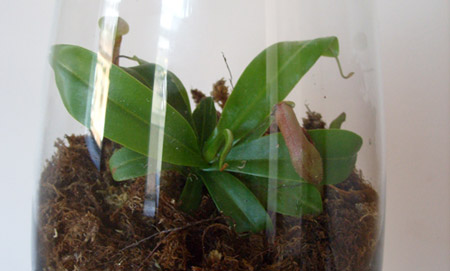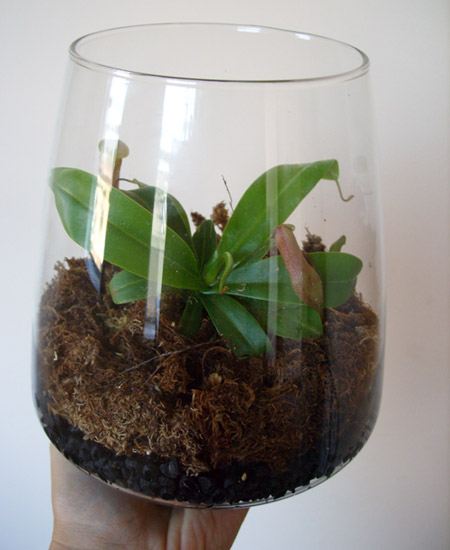
Look what my spouse brought home for me yesterday as a gift for being sick. If this is what I get for being sick what do I get for being a fully-functioning, productive member of society? Actually being sick was a nice excuse to lay in bed watching Wonder Woman reruns and re-reading back issues of Bitch Magazine until today, the forth day, which just happens to be one day too long. I am both exhausted and bored out of my skull. Those last days of summer are passing me by while I sleep all day, wallowing in my own unshowered filth.
But this is not about being sick, this is supposed to be about the plant. When he presented me with this Nepenthes ventricosa all fancified in a perfect little box, complete with tissue paper and ribbon I have to admit that after the initial excitement and flattery my “thriftiness” (read cheapness) kicked in and my second thought was “But I could have put this together myself for about ten bucks!” I haven’t asked him how much it actually cost. I don’t want to know. Knowing might kill me if this unknown virus or utter boredom doesn’t first.

If you want to make something like this easily and without gift-store/fancy-pants floral shop prices here’s what you do:
1. Get yourself a pretty glass bowl, fish bowl, candy bowl or terrarium. Department stores sell them in the pet section and so do thrift stores.
2. Line the bowl with approximately 2-3 inches of gravel. This can also be purchased cheaply in a pet store. Gravel is inexpensive when purchased from the pet department. Repackaged as floral gravel and the price is jacked sky high. Go figure.
3. Add about 2 inches of long fiber sphagnum moss to the bowl. Remove the small Nepenthes plant from it’s pot and plant into the sphagnum. Personally I am not a fan of pure sphagnum as the “soil” for this plant. The Nepenthes will certainly survive since the sphagnum provides a light and airy bed that doesn’t stay too damp just as Nepenthes’ roots require, however the sphagnum can dry out too easily if you don’t watch it like a hawk. Try the following instead:
Nepenthes Soil Mix
-
Mix together:
- 1 part long fiber sphagnum moss
- 1 part orchid bark mix
- 1 part regular peat or coir
Quick Nepenthes Growing Tips
- Two Tribes: Nepenthes are divided into two kinds: highland and lowland species. The plant in my terrarium is probably the most common variety, a highland species called Nepenthes ventricosa. Their name says a lot about where and how they grow with highlanders growing up in the mountains at a high elevations and lowlanders growing in hot, lowland tropical locations. As a result highlanders can withstand much lower temperatures as well as some fluctuations making them better suited to your average home or apartment. Lowlanders are better suited to greenhouses where conditions are very humid and stable.
- Drainage: Unlike many other popular carnivorous plants Nepenthes are not bog growers. Instead, many types thrive in the tropics, growing epiphytically perched in trees much like many orchids. All of this means that they require lots of good drainage. A container with drainage holes is preferred so if you’re planning to go the terrarium bowl route than be sure to add lots of gravel and water carefully.
- Water: Like all carnivorous plants you MUST use water low in dissolved mineral salts — your plant will die otherwise. Carnivores may seem tough as nails but they are a sensitive sort really — they’re sort of like the Jane Seymores of the plant world. Try collecting a little rain water now and again into a clean bowl and then funnel it into a bottle or jar for storage. If you’ve got a reverse osmosis filter at home you can use water from that otherwise you’re gonna be reduced to shelling out a few bucks now and again for special low-sodium or distilled bottled water.
Nepenthes do not like wet feet — let the water in the gravel dry out just a little before adding more.
- Temperatures: Nepenthes are tropical plants. While the highlanders can tolerate some temperature dips they should be kept in the high 70s F with night time temperatures that drop slightly into the mid 50s F to low 60s F.
- Light: Nepenthes generally prefer bright but diffused light.
- Humidity: Your plant will require humidity in order to produce more pitchers. A glass bowl like mine will go a long way in keeping humidity levels up around the leaves. You can also spritz your plants once or twice daily with the same de-mineralized water used to water.
Related Articles
- Read This: If you are at all interested in growing carnvivorous plants I highly recommend The Savage Garden by Peter D’Amato. His book came out in 1998 and it is still by far the most interesting and most comprehensive book for home growers that I have seen.
- The Carnivorous Plant FAQ: This is a great site if you’re interested in learning more about carnivores and how to care for them. There are also some fascinating pictures following author Barry Rice’s trips to carnivorous plant locations. The Nepenthes section begins here.
- Grow a Carnivorous Bog: I’m a huge carnivorous plant fan and have a project in my book that walks you through the steps involved in putting together a container-grown carnivorous bog that can be kept on a porch, balcony, or deck. pgs 110-111. Just remember that unlike many carnivorous plants, Nepenthes are not a bog plant.
- Get Some: Look for nurseries and plant societies that do not acquire their plants through field collection. If you’re in the U.S try California Carnivores. Canadians can try Keehns Carnivores in B.C.
Sorry to hear you are sick, but you did luck out with the plant! You gave some great info and I’m going to look into getting myself one of these. They are beautiful and I love carnivorous plants… and I want one!
Hope you are feeling better soon!
How sad that you are sick at the end of summer!! I hate being sick any time the temperature is over zero celsius!
I wanted to ask you about the gravel you speak of: when you say it can be acquired from the pet store do you mean fish tank gravel, or kitty litter? Thanks – I love your site!
I’m actually going to hear Peter D’Amato speak at the Atlanta Botanical Garden about carnivorous plants in a couple of hours. I’ll have to pick up his book.
I’ve got a few glass bowls lying around that I need to do something with. Any other plants you’d think would work well in that situation?
That’s awesome cara. I would recommend a Sundew (Drosera) or two, or three for these little terrarium setups. The Nepenthes are great but they can grow to be quite large and will eventually need to live in a hanging basket. Sundews stay small forever and are just gorgeous.
You can also try Sarrancenia purpurea, the cold hardy pitcher plant that is native to my part of the world. They stay short enough for a terrarium.
I was really excited by this post because I’ve lately become obsessed with terrariums and can’t wait to start making my own. I’ve found that ebay has a lot of nice, inexpensive glass containers, apothecary jars, and the like.
Thank you for the info. Get well soon!
Oh yes I love apothecary jars. Here are a few more carnivorous terrariums I built for a gardening event last year.
http://www.flickr.com/photos/yougrowgirl/152279994/
I did a bromeliad terrarium as well but will have to dig up a photo.
Wendy: Sorry I missed your question. Definitely use fish gravel. It comes in all sorts of colours and is usually only $2-5 at most for the amount you will need for a small bowl.
hmm, actually, I bet that isn’t gravel at all at the bottom of your terrarium. It’s probably charcoal. charcoal’s supposed to help absorb the stinkiness that accumulates in undrained containers.
Flytrap: No it’s gravel. They didn’t put charcoal in this one.
I don’t think it is necessary with the nepenthes that dries slightly before rewatering but I do with the bog plants.
Hey there:
I have been painting the image of these pods in many ways for many, many years. The pods or pitchers they form are visually astounding! I finally got, as a gift, one of these wonderful plants. It is alive one year now! But all the pitchers dried up. It did very well hanging from a tree outside during the summer in NJ. It is back inside now but not growing any new pitchers, I would imagine because of the humidity problem. Is it fine that the cloche (when I get one) is open on top and still sufficient for humidity? My plant is pretty big and hanging (about 12 inches tall). The pitchers that were on the plant when I first received it hung down beyond the pot. Will planting in the cloche hinder the pitcher growth or happiness at all?
Thanks for response.
Tina
I had a flytrap but it died quick.:(
Danielle: Venus flytraps are not easy.
Tina: The trick is to get both humidity and air circulation so it is definitely important that the cloche is open at the top.